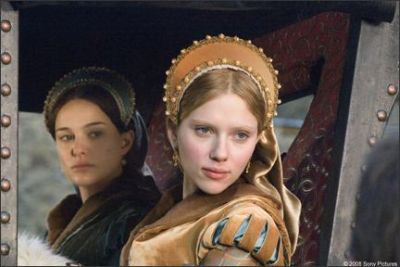
In her bestselling novel The Other Boleyn Girl, Philippa Gregory spins a new take on a very old story: the ill-fated romance between King Henry VIII and his second wife, Anne Boleyn. With a twin focus on Henry's relationship with Anne as well as his illicit affair with Anne's sister, Mary, Gregory's novel portrays the court of the Tudors as a home for sex, intrigue, and power games.
"I think before I wrote the novel, hardly anyone knew about Mary Boleyn," Gregory says. "She was a character hidden from history, maybe because historians weren't interested in her, because she made no difference to the historical record. But I saw her story as a contrast between sisters, and that contrast was fertile ground. It becomes a parable for the way women make use of their opportunities."
For director Justin Chadwick, the central relationship in The Other Boleyn Girl is not necessarily the famous one between Henry and Anne but the one between Anne and her sister, Mary, who vied with her for the king's attention. "Anne and Mary do some terrible things to each other, there's rivalry and jealousy between them, but ultimately, they're sisters," he says. "You have a relationship with your sister that's different from any other person. You have conversations behind closed doors, talking to her in a completely different way. You can be completely open and honest with her. Like Mary says, it's like being two halves of the same person."
Of course, sisters can be horrible to each other, as well. "This is like a mafia story in the court of the Tudors," says producer Alison Owen. "It's got sex, rivalry, jealousy, ambition, scandal -- with sisters at the heart of the story."
Chadwick found his Boleyn sisters in two award-winning actresses, Natalie Portman and Scarlett Johansson. "They brought something to the roles, some sibling intimacy, some closeness, that meant we could take scenes further than the written page," he notes. "During the course of the film, the sisters' relationship changes, but they remain tied together as sisters. Natalie and Scarlett portray that beautifully."
Portman takes on the role of Anne Boleyn, who would replace her sister as the king's mistress, becoming his queen. "It's easy to see the story for its place in history, but at its heart it is a family story, a story between sisters," says Portman.
Johansson plays the "other" Boleyn girl, Mary, who would happily fade into history. "Sibling relationships are complicated," she says. "Everyone can understand that jealousy and competition. The bond is very strong; only your siblings can read you so well and know instinctively how you feel."
Of course, when a sibling rivalry is placed at a pivotal moment in history, the stakes are raised and the risks and rewards are both great. Chadwick notes, "We start with three innocent children, Anne, Mary, and George Boleyn, and chart their journey from a country field to the throne to the scaffold. Their lives go horribly wrong through ambition and greed. The nastiness and intrigue will speak to a modern audience, as a reflection on obsession with celebrity and a warning to be careful that you don't lose your head, in their case literally, over your ambition."
Peter Morgan, who was nominated for an Academy Award for his screenplay for The Queen, was eager to adapt Philippa Gregory's novel for the screen. "Though I'd already tackled Henry (for an award-winning television drama starring Ray Winstone), I became hooked when I realized that this was a story from a completely different perspective," he says. "It's written with such energy and gusto and the two sisters are such fantastic polar opposites. Anne is a proper 16th Century diva -- strong minded, stubborn, and manipulative -- who accomplishes one of the great historical seductions, and manages to withhold her favors from the most powerful man in her world till she gets what she wants. She is the family favorite, in pole position, and needs the limelight. Mary is much more complicated; she has a higher emotional intelligence, an inner spirituality and is quite feisty and unbending in her own way."
"Whichever sister becomes the more successful in their rivalry for the king's affections, the other one becomes the `other' Boleyn," Portman says. "Anne totally buys into the whole competition, while Mary chooses a way to be happy without life in the court, and she ultimately wins by allowing Anne to have the victory that destroys her. It's a family story, with love and intrigue, about children who are corrupted by a world which pushes them to compete rather than support each other. Mary, the survivor, is the one who rejects that world."
Joining Portman and Johansson are Eric Bana as King Henry VIII, Kristin Scott Thomas as Lady Elizabeth, rising star Jim Sturgess as George Boleyn, Mark Rylance as Sir Thomas Boleyn, and David Morrissey as the Duke of Norfolk.
To bring the motion picture to life, Chadwick called upon a team of specialists, including Emmy-winning production designer John-Paul Kelly and two-time Oscar®-winning costume designer Sandy Powell. The film also employed an etiquette advisor, Noel Butler, to give special insight into the customs and mores of the royal court.
Summing up his experience, Chadwick says, "I want the audience to believe that there might be hope for Anne, even though everyone knows her fate. I hope they'll follow the twists and turns of the story and wish that Anne gets a reprieve."
No comments:
Post a Comment